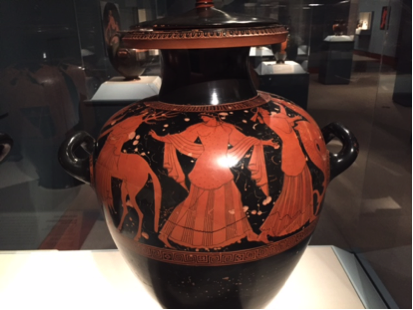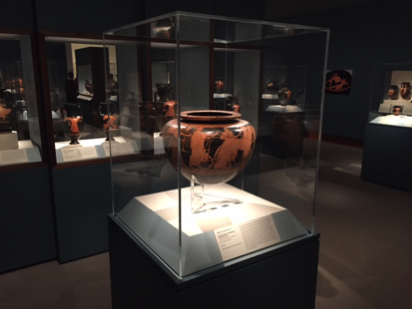
Art review: “The Berlin Painter and His World: Athenian Vase Painting in the Early Fifth Century B.C.”; Princeton Art Museum, March 4 – June 11, 2017
Bernie Langs
There are certain types of art exhibits that are more difficult to take in than others. I have always found, for example, that illuminated manuscript displays require a very tiring amount of concentration, though the effort is well worth the wonder evoked. Exhibitions of sculpture, unless of ancient pieces, and drawings (excluding those from the Renaissance) require a great deal of disciplined looking to garner the rewards of understanding.
In the 1980s and early 1990s, I would often visit exhibitions at the Metropolitan Museum of Art and explore the permanent collection at length. At times, I’d be the only person lost in The Met’s side rooms displaying a huge inventory of ancient Greek vases, drinking cups, oil vessels, etc. There were cases and cases of them, many works graced by explanations written on typewriters indicating years of neglect and lack of attention. A few years ago, that all changed. The prize vases are now on glorious and ordered display, dozens of smaller, “lesser” works are upstairs from the main floor of the Leon Levy and Shelby White Court in a large, new repository and massive “study” space of ancient treasures that draw only a few curious, and, at times, quite knowledgeable viewers.
“The Berlin Painter and His World: Athenian Vase-Painting in the Early Fifth Century B.C.” at the Princeton Art Museum (March 4 – June 11, 2017) is a rare kind of exhibition. I can’t recall a major museum show featuring ancient Greek vases, let alone one centering around the works of an individual artist from this obscure period when attributions are hard to come by. I had no idea what I’d find when I drove out to Princeton on a March morning, but I had high hopes that the illustrious Ivy League institution would do the subject justice.
The magnificent exhibit is the fruit of decades of study on individual hands that can be catalogued from the time around 500 B.C. and later. Sir John D. Beazley (1885 – 1970) is noted by the curators as the first scholar who began cataloging vases to individual painters and The Berlin Painter is one of those who left no signature, but surely a recognizable and signature style. When one is dealing with the subject of actual artists from the Golden Age of Greek art and beyond, those of us who love art history are in awe of the mere mention of a sculptor, such as Praxiteles (4th century BC), or Apelles, a painter also of the Hellenistic Period. There are no remains of either of their outputs, but many “copies” and much speculation about what they produced and just what their works may have looked like. Apelles was legendary even in the days of Julius Caesar and inspired the Renaissance artist Botticelli to attempt to recreate one of the artist’s most famous works from antiquity (“The Calumny of Apelles”).
At the Princeton show, one easily finds a name, a style, and the hand of an exemplary artist. The various figures depicted on the vases in “red figure” style are elegant, smooth, and represent everything from mythical beings, to gods, athletes, fantastic beasts, wrestlers in repose, and so on, all adorned in smooth, simple, flowing chitons and draperies. There are swords and war, there are mystic offerings, there is Herakles undertaking his many tests, trials and tribulations, and there is the life and leisure of the ancients. One’s eyes widen in wonder at what is in the display cases.

The exhibit’s explanations are concise and very much on point, giving everything from historical context to notes on how one creates these pieces of pottery. The placards for each vase were also spot on, and I never found myself reading and drifting off to mutter “that’s a lot of words” which I often do. There was one very beautiful wine vessel that the museum noted was found completely intact. Most vases are pieced together from fragments, and in this exhibition, the viewer is blessed that most of the vessels displayed were not broken up too badly when they were found in either The Berlin Painter’s home area of Athens or in Etruscan Italy, an export destination. I can’t recall ever previously viewing a major Attic Red-figure vase that was found entirely in one piece, as if it was fresh from production and presented for use that very day in New Jersey.
When I was done visiting the galleries of the exhibition, I took in sections of the museum’s permanent collection and out of nowhere, I raced back to view The Berlin Painter with fresh eyes. I now knew how to approach it, and how to see it. On this second go-around, spending time with only the top pieces, they truly came to life and felt more vital and immediate to me. Cicero has a book called “On the Nature of the Gods” and the stamnos depicting Chiron, Nereus and Nereids (see photo) truly reflected The Berlin Painter’s notion of the cosmography by which he was bound by in space and historical time. By believing one could, for a moment, see the graceful mythic beings through his eyes, the cosmic dance commences, and it really is quite a show.
